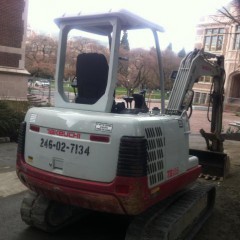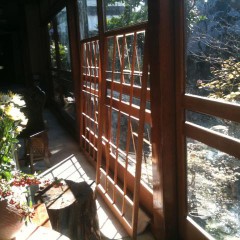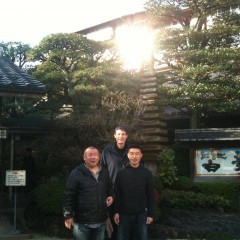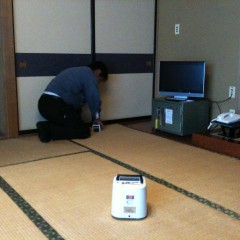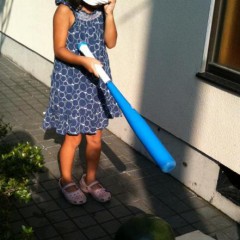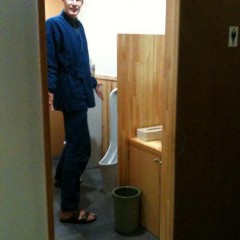
丸見え! だから?
欧米人が日本に来たら、良くある驚きはトイレです。良い風に(ハイテックな最新のトイレが宇宙船の席みたい!)と、良くはない(和式を初めて見て、「何これ?床に穴が…」)、両方のショックを受ける。立ち小便が良く見る事や、男子トイレに入っている時に掃除のおばさんが平気で入ったり、一般的に色々なショックを受ける。
しかし、このブログは一般的な観光者のブログではなくて、温泉旅館を経営している青い目の若旦那のブログです。大学の頃から日本に行ったり来たりしているし、若旦那になって5年間も経ちました。もう、トイレの習慣の違い何って、慣れてしまった。 と思っちゃうのは危険だね。
我が宿でトイレの改造を計画しています。その中で、廊下のトイレの事、気になっている2点があって、今回の改造でそれを直したいと思っていました。男子トイレは大便器1台、小便器2台と洗面器1台。奥からその順番。入口は引きドアとなっている。私にとっての問題2点は:
1.お客さんが入る時に引きドアを閉じないままで小便器を使って、廊下から丸見え事があります。その問題を解決するために入口は引きドアから開きドアに変えたい。
2.開きドアにしたら、開く時に洗面器を使っている人にぶつけないように、洗面器を奥にずらさないと駄目。そう考えれば小便器は1台多い。1台を減らせば洗面器を奥に移れる。男二人が同時に小便しに来れば、一人は大便器を使えばいいだろうと。
こういう戦略を設備屋さん、女将社長、色んな人と相談したら、皆に納得できなさそうな顔をされた。追求すれば、やっと分かった。日米関係のトイレに関する習慣の違いが出てきた。私が今まで気付かなかった2点:
1.小便している姿が丸見えと、日本人には大した事ない。
アメリカでは、小便器は入り口から必ず隠れていて、外を通る人から絶対に見られない作り。私は日本で公園とかのトイレで小便をし、外から丸見えだと、何度も思われた事がある。
2.日本の男子は小便を大便器でするのは抵抗がある。
現代の日本では、洋式トイレが多くなっていますが和式で育ってきた方がまだまだ多い。和式トイレじゃ小便に向いていなくて小便器も大体あったと。その様に育ってきた男性に小便は小便器でと言う習慣が強い;トイレは様式になっても大便にしか使いたくない。だから、私の考えていた「男二人が同時に小便しに来れば、一人は大便器を使えばいいだろう」事は日本人に通じない。逆に、お客さんに不便を与える。
ちなみに、私は小さいころから洋式トイレに小便もする習慣で育ってきました。お父ちゃんと二人で家のトイレを同時に使って、小便が「X」となっていて、「あっ、飛行機みたい!」の様な子供のころから思い出もある。
亀清旅館のお客さんの9割は日本人なので今回は日本流に従って、この部分のトイレ改造を中止しました。良い勉強になりました。
When Americans come to Japan, we are often surprised by the toilets, both in positive ways ("Wow, this high tech toilet is like James Kirk's Captain's Chair!"), and not so positive ways ("That toilet -- it's just a hole in the ground!). Not to mention being surprised at the prevalance of guys taking a pee out in public, or the occasional incidence of innocently using the guys bathroom and seeing a cleaning lady come through with a mop.
But those are typical types of "culture shock" that Americans have as tourists in Japan. However, this blog isn't a touristy blog; it's a serious (?) attempt at tracking the daily experiences of me, an American innkeeper at a traditional Japanese onsen ryokan. I've been coming and going to Japan for over 2 decades, and have been running this inn for 5 years, so I'm used to the culture differences regarding toilets. Or so I thought...
We are planning a bathroom remodel here at Kamesei, and as part of it I intended to take care of 2 problems that I perceived with our main toilet. The guys side has a regular toilet, 2 urinals, and a sink, in that order from back to front. The entrance is a sliding door. The 2 problems are:
1. Several times guests have neglected to pull the door shut leaving their urinal usage totally visible to passers-by. The door needs to be changed to a hinged door that automatically shuts.
2. Such a hinged door would swing open right into anyone using the sink, the sink would need to be scooted back. One of the urinals would have to be removed in order to accommodate that. If two guys went to the bathroom room at the same time, one could simply use the toilet as a urinal.
In explaining this scheme to the contractors, others at our inn, and anyone else who would listen, I was systematically met with incredulous looks. As I looked into the matter, I was fascinated to discover two differences between American and Japanese perspectives on toilets:
1. Japanese don't have an issue with seeing or being seen while urinating.
Back in the States, the openings to bathrooms are always configured in such a way that it is impossible to see the urinals from outside. Here in Japan, numerous times I have been surprised to use a urinal and have been aware that passers can easily look in and see me going about my business.
2. Japanese men prefer to urinate in a urinal.
Nowadays, Western style toilets are more prevalent than the traditional Japanese style which is basically a porcelain hole in the floor. The Japanese style isn't suited for urinating, and has historically been paired with a urinal. Many Japanese men have hence grown up using a urinal for urinating. Even though the toilets have been gradually changed to Western style, the preference to urinate in a urinal prevades. So, my thought that, "If two guys went to the bathroom room at the same time, one could simply use the toilet as a urinal" doesn't swing it here in Japan.
Since 90% of our guests here at Kamesei Ryokan continue to be Japanese, for now I'll let the local customs guide our bathroom remodel. This whole issue has been a learning experience for me!
